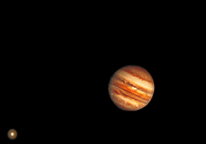 |
||||||
|
PART 2 PART 1 |
||||||
|
The Planets Mix It Up As the solar nebula spun, gases at the center collapsed to form the Sun. The remaining cloud flattened into a rotating disk, and gravity caused denser areas of gas and dust to shrink and condense into objects called planetesimals, about a kilometer in size. Some planetesimals collided and stuck together as they whirled around, forming blobs which grew into the planets. Planets are a few thousands of kilometers across. But some of the planetesimals in the solar system did not become part of a planet. Scientists think they know how planetesimals may have been ejected from the inner solar system into the Oort Cloud.
Some of these ejected bodies probably left the early solar system and never returned. Some probably collided with other planets or moons, making the craters we can still see through telescopes. Others left the plane where the planets travel, but remained in large oval-shaped orbits with one end around the Sun. These objects formed the Oort Cloud- a huge cloud of comets. Solar System Waistband Many small bodies also formed at the cold outer edge of the flattened planetary disk, beyond Uranus and Neptune. Recent research indicates that this "inner cloud" or comet "belt" is probably the source of most of our well-known comets, like Comet Halley. It is now called the Kuiper Belt (Kuiper rhymes with "wiper"), after the astronomer who first guessed it would be there.
The Kuiper Belt may actually contain 10 to 100 times as many comets as the Oort Cloud. However, these objects are very hard to count. They are so tiny, and reflect so little sunlight that they are quite hard to see, even with a telescope. ? The Kuiper Belt and the Oort Cloud both contain many comets. How is the Kuiper Belt different from the Oort Cloud? Hint: Think size and shape. All of the comets in the Kuiper Belt and Oort Cloud are part of the solar system. They travel around our star the Sun, and obey the same laws of motion as the planets and their moons. However, only a very few comets come close to the Sun, where we can see them from Earth. Most comets travel on paths beyond the 9th planet Pluto, or even further out, in the Oort Cloud. Next: why astronomers get excited about comets, and our latest comet visitor. |
||||||
|
|
||||||
|
ęCopyright 2000 Regents of the University of California. |

